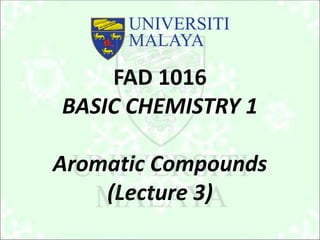
LECTURE NOTE Aromatic Compound_Student_lecture 3.pdf
- 1. FAD 1016 BASIC CHEMISTRY 1 Aromatic Compounds (Lecture 3)
- 2. Resonance effect and inductive effect • RESONANCE effects are those that occur (withdrawal or donation of electrons) through the π system and can be represented by resonance structures. These can be either electron donating (e.g. -OCH3) where π electrons are pushed toward the arene or electron withdrawing (e.g. -C=O) where π electrons are drawn away from the arene. • INDUCTIVE effects are those that occur (withdrawal or donation of electrons) through the σ system due to electronegativity effects. These also can be either electron donating (e.g. -CH3) where σ electrons are pushed toward the arene or electron withdrawing (e.g. -F, -+NR3) where σ electrons are drawn away from the arene. • Electron donating groups are alkyl groups, phenyl groups or substituents that have a lone pair of electrons on the atom directly bonded to the ring. • Electron withdrawing groups have an atom with a slight positive or full positive charge directly attached to a benzene ring.
- 3. Effect of Substituents in substituted aromatic rings: Reactivity and Orientation Substituent groups present in the benzene ring can influence the rate of electrophilic substituents and orientation of the products formed. • Effects on the reactivity: – Deactivating group – a group that decreases the reactivity of the ring towards electrophilic aromatic substitution reaction as compared to benzene (less reactive than benzene). – Activating group- a group that increases the reactivity of the ring towards electrophilic aromatic substitution reaction as compared to benzene (more reactive than benzene). • Effect on the orientation: – Ortho-para directing group (director) – a group that directs the electrophile to ortho and para positions . – Meta directing group (director) – a group that directs electrophile to meta position.
- 4. Reaction of Monosubstituted Benzene
- 5. Source: https://www.masterorganicchemistry.com/2018/01/29/ortho-para-and-meta-directors-in-electrophilic-aromatic-substitution/ - ortho-para directors & activating groups - *ortho-para directors & deactivating groups (halogens)* - meta directors & deactivating groups
- 6. - ortho-para directors & activating groups - *ortho-para directors & deactivating groups (halogens)* - meta directors & deactivating groups *Halogen- ortho-para director but deactivating Source: John McMurry, Organic Chemistry
- 7. Ortho-para directors • Ortho and para directors are electron donating groups. • The C2 (ortho) and C4 (para) positions are the sites predominantly affected by the increase in electron density. Hence, these positions are more susceptible to attack by electrophiles. • Electrophile attack at the ortho (C2) or para (C4) positions will lead to a tertiary carbocation which is more stable. • Electron donating group increase the electron density around a benzene ring. Hence, electron-donating groups are activating groups and they increase the rate of substitution. • All ortho-para directors except for alkyl, aryl and CH=CHR groups, have at least one lone pair on the atom directly attached to the ring.
- 9. Ortho-para directors Source: John McMurry, Organic Chemistry
- 10. Examples:
- 11. Meta directors • Meta-directing groups are electron withdrawing groups. • Electrons are withdrawn mainly from the C2 and C4 positions, rendering the C3 position relatively richer in electrons. Consequently, any further substitution attack by an electrophile takes place preferentially in the C3 position (meta position). • Electrophile attack at the ortho (C2) or para (C4) positions will lead to a carbocation in which a positive charge is situated adjacent to the positively charged / electron withdrawing substituent, which is unfavorable. • Electron withdrawing groups reduce the availability of electrons around the ring. Hence, electron-withdrawing groups are deactivating groups and they decrease the rate of substitution. • All meta directors have a positive charge or a partial positive charge on the atom attached to the ring.
- 13. Meta directors Source: John McMurry, Organic Chemistry
- 14. Examples:
- 15. Special: Halogens as ortho-para directors even though they deactivate the ring • Halogen substituents are a little unusual in which they are deactivating but still direct electrophile to ortho-, para positions. • Halogens are deactivating because their stronger electron withdrawing inductive effect (due to electronegativity) outweights their weaker electron-donating resonance effect (due to lone pair of electrons). • Although weak, that electron donating resonance effect is felt only at the ortho and para positions. Hence, halogen substituent can stabilize the positive charge of the carbocation intermediates from ortho and para reaction. (The ortho and para intermediate are more stable than the meta intermediate due to the electron donation of halogen).
- 16. Special: Halogens as ortho-para directors even though they deactivate the ring Source: John McMurry, Organic Chemistry
- 17. Tricks to determine electron donating and electron withdrawing groups If Z more electronegative than Y = Electron withdrawing group If Y more electronegative than Z = Electron donating group If Y is with (+) = Electron withdrawing group Note: Most of the groups can apply these tricks but still have exception/groups that cannot apply this tricks. For example: Between H and O, choose the most electronegative atom as the Z. So Z here is referring to O and Y is C. O is more electronegative than C, so CHO is electron withdrawing group.